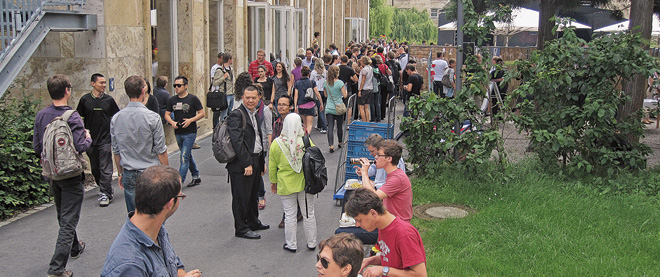No need for a scholarship
The promise of free tuition has an increasing number of Canadian students heading to Germany
Share

Five people were arrested in Quebec in early April for protesting a $325 increase to annual tuition fees. By 2016, tuition in the province will hit $3,800 a year. But that’s still a bargain compared to Ontario, where the average bill tops $6,500. So it’s no wonder an increasing number of Canadian students are studying in Germany, where tuition is free for citizens and foreigners alike. There are currently 534 Canadians enrolled at German universities—up 52 per cent since 2002.
Peter Gilfoy, a 23-year-old from Halifax, couldn’t believe his luck when he stumbled upon free tuition during his year-long exchange at the University of Frankfurt. He had already paid his fees for that semester to Saint Mary’s University in Halifax, where he’s now finishing his commerce degree. But free tuition allowed him to stay an extra year in Frankfurt and take university courses simply to improve his German.
He was even more surprised when students marched in the streets to protest a new fee: $280 to cover their train pass. “I was in awe considering they know full well how much Canadians and Americans pay,” he says. Gilfoy also found bargains on rent, beer—only $1.50 per half-litre—and cafeteria food, which is government-subsidized.
But it’s not only free tuition that is attracting Canadians. Translating the traditional German diplom and magister degrees for Canadian employers has always been difficult, says Jessica Denenberg, an information officer of DAAD Toronto, an organization that encourages academic exchange with Germany. But over the past few years, universities in Germany have been phasing out the old degrees in exchange for North American style bachelor’s and master’s degrees.
The only major difference left is that most German students finish their bachelor degrees in three years instead of four, which is now the norm for Canadians. That’s because they spend six weeks after each four-month semester writing papers and tests. It’s easy considering they don’t need to work for cash in between semesters.
Another obstacle for prospective students that’s been overcome is a lack of German language skills. It’s less of a problem now that the number of bachelor’s programs taught in English has topped 100. And for those who opt for programs in Deutsch, as Gilfoy did, fellow students speak enough English that they can easily converse, he says.
One might also assume a school with free tuition would be filled with slackers dumbing-down seminars, or that the education is of lower quality. But Gilfoy and Denenberg both argue that German facilities are comparable to Canadian schools they’ve attended, and that German students generally take academics more seriously.
But Canadians considering a discount degree in Europe might want to act fast. Sweden and Finland, which used to entice international students with free tuition, are now going to start charging foreigners. Master’s degrees that were once free to Canadians at Lund University in Sweden, for instance, will cost $17,000 per year, starting this fall. Germany, along with Norway, are among a dwindling group of tuition-free holdouts.
It will be difficult for Gilfoy to pass up more free education. He plans to apply to master’s programs in both Canada and Germany next year. Queen’s or Dalhousie would require that he take out a line of credit at the bank. A master’s at Frankfurt, meanwhile, would cost only the $280 per semester train fee. So if he gets into a German school, he could graduate debt free—even when you factor in those $1.50 beers.